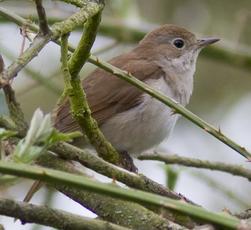Nightingale - Luscinia megarhynchos
Nightingales are slightly larger than robins, with a robust, broad-tailed, rather plain brown appearance.
A secretive bird which likes nothing better than hiding in the middle of an impenetrable bush or thicket. In the UK they breed mostly south of the Severn-Wash line and east from Dorset to Kent. The highest densities are found in the south east: Essex, Suffolk, Norfolk, Kent and Sussex.
They arrive in April and sing until late May and early June. They leave again from July to September. They can be heard singing throughout the day, as well as at night.
They feed on insects.
Local and occasional in the UK with nearly all records coming from an area south of a line from the Severn to the Humber.
Infrequent in Leicestershire and Rutland.
Leicestershire & Rutland Map
Enter a town or village to see local records
MAP KEY:
Yellow squares = NBN records (all known data)
Coloured circles = NatureSpot records: 2020+ | 2015-2019 | pre-2015
UK Map
Species profile
- Common names
- Common Nightingale, Nightingale
- Species group:
- Birds
- Kingdom:
- Animalia
- Order:
- Passeriformes
- Family:
- Muscicapidae
- Records on NatureSpot:
- 14
- First record:
- 25/04/2008 (Chris Lythall)
- Last record:
- 19/05/2019 (Palmer, Paul)
Total records by month
% of records within its species group
10km squares with records
The latest images and records displayed below include those awaiting verification checks so we cannot guarantee that every identification is correct. Once accepted, the record displays a green tick.
In the Latest Records section, click on the header to sort A-Z, and again to sort Z-A. Use the header boxes to filter the list.




